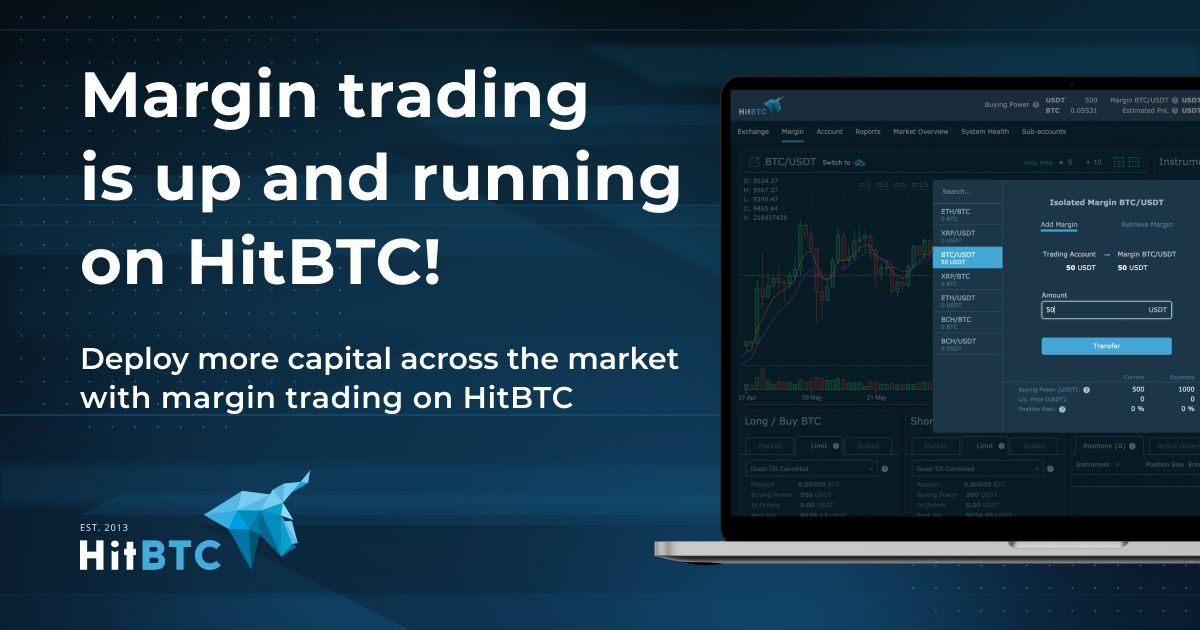HitBTC Introduces Margin Trading on the Main Platform


We are pleased to announce that we’ve added a margin trading tool, previously a core feature of Demo HitBTC, to the main platform, giving our users the opportunity to leverage the funds they already have. By operating with a certain amount of money borrowed from the exchange, users will be able to amplify their trading positions and multiply their potential gains. But first, to open a trade, they have to put forward collateral equivalent to a particular percentage of the full value of the position. This collateral constitutes the margin.
This tool can be used for all the order types currently available with normal trading. The only thing different is the amount of potential profit, which increases due to the ratio of borrowed funds to the margin that is leveraged. Currently, to get a taste of crypto margin trading, HitBTC is offering a leverage rate of 10x for five markets including BCH/USDT, XRP/USDT, ETH/BTC, BCH/BTC, XRP/BTC, and now up 12x for BTC/USDT, ETH/USDT.
Update: New pairs added to our new margin trading feature! Enjoy up to 10x leverage on EOS/USDT, TRX/USDT, LTC/USDT, ETC/USDT, ADA/USDT, EOS/BTC, TRX/BTC, LTC/BTC, ETC/BTC, ADA/BTC and up to 5x leverage on BSV/USDT, ZEC/USDT, DASH/USDT, XLM/USDT, BSV/BTC, ZEC/BTC, DASH/BTC, XLM/BTC.
How does margin trading work?
Let’s consider a hypothetical example. Let’s say you have 400 ETH on your account balance, or enough ETH to purchase 10 BTC. After a while, you see the price of the latter increases by 100 units, so you decide to sell 10 BTC for 1400 ETH. Consequently, your profit here is 1000 units.
And now suppose that you would like to use the maximum x10 leverage and borrow 3600 ETH from the margin lender, depositing the same 400 units as collateral. Then you spend your 4000 ETH to buy 100 BTC. In this scenario, if the price of the latter increases by the same 100 units, you will be able to sell your 100 BTC for 14,000 ETH and gain a profit of 13,600 units – or ten times more than you would have made with only your initial investment.
This also works when market prices drop. In this scenario, you take your 400 ETH and sell them for 94,000 USDT. If the price of the former falls by 200 units, you then will have an opportunity to buy these 400 ETH for 14,000 USDT, leaving you with 80,000 more USDT as a profit.
But if we add 3600 ETH borrowed from a broker and sell 4000 ETH for 940,000 USDT, the same price drop will result in the ability to get your 4000 ETH back for 140,000 USDT, plus a profit of 800,000 USDT, which is ten times more than you would have had without using margin.
Margin call level and margin liquidation level
The margin call level applies to the ratio of your account balance to the used margin, calculated in percent, at which your open positions are close to be liquidated by a broker. When this happens, users will receive a call notification in the form of a pop-up appearing in the browser and suggesting that they either close some of their positions or add some more funds to their margin. But it is also crucial to constantly monitor the margin level yourself in order to be able to increase the amount of collateral and reduce liquidation risks in time. At margin call level no automatic liquidation occurs.
Margin liquidation level is the level that initiates the automated liquidation process, meaning that it is no longer possible to prevent the liquidation once it has started. In our case this occurs when the market price is equal to the liquidation price established by the exchange.
PNL (profit and loss)
PNL is the capital gains you have accumulated, measured in USD, between your deposit and your final payouts. PNL is credited to your balance as soon as you close your position and can be subsequently transferred to your trading account along with collateral funds.
The partial closing of an open trade will realize your PNL in proportion to the value of the relevant position, which users are enabled to both increase and decrease within the valid buying power range.
Margin fees
All fees charged by a broker for the use of borrowed funds are in addition to the regular trading fees that vary based on the total volume of the trade. Our margin fees are fixed, so they do not depend on the period of time during which your position is open, and offset independently once every eight hours from your margin account.
Margin trading advantages
This tool allows traders to expand their market activity by increasing their position sizes. You can try Bitcoin margin trading if your account balance is not sufficient to trade, but you consider the market conditions to be favourable. Moreover, with margin trading you have the opportunity to boost your gains in a much shorter period of time.
However, doing this successfully requires a more advanced level of knowledge and trade experience, owing to the high volatility of the crypto market. If you are a novice in margin trading, we highly recommend that you practice this strategy on our demo platform first before trading with real funds. You can find more information on how to get started on Demo HitBTC here.
But one more rule, which is always appropriate in crypto, is that you should do your own research and trade in accordance with the current market situation.
Get started
To start margin trading, head over to the relevant tab and press “Margin” to add collateral funds to a margin account. Please keep in mind that at this stage your verification level and 2-factor authentication status will be checked. Then choose your trading instrument in the pop-up, enter the amount of your collateral into “Amount” and press “Transfer.”
It is noteworthy that the sum transferred to the balance cannot exceed the amount of funds stored on the trading account and will be used for operating the particular trading instrument you have chosen.
Now you are ready to trade on margin with an enhanced buying power. Later, you can examine the history of all your requests, trades, positions and fee charges via the terminal or Reports tab.
Good luck!
